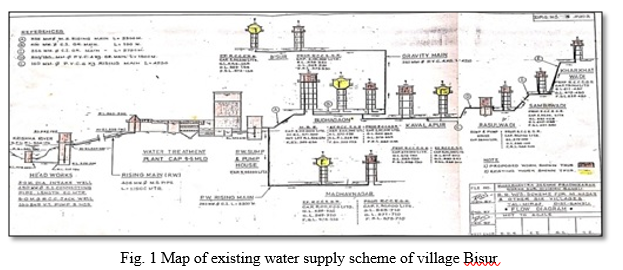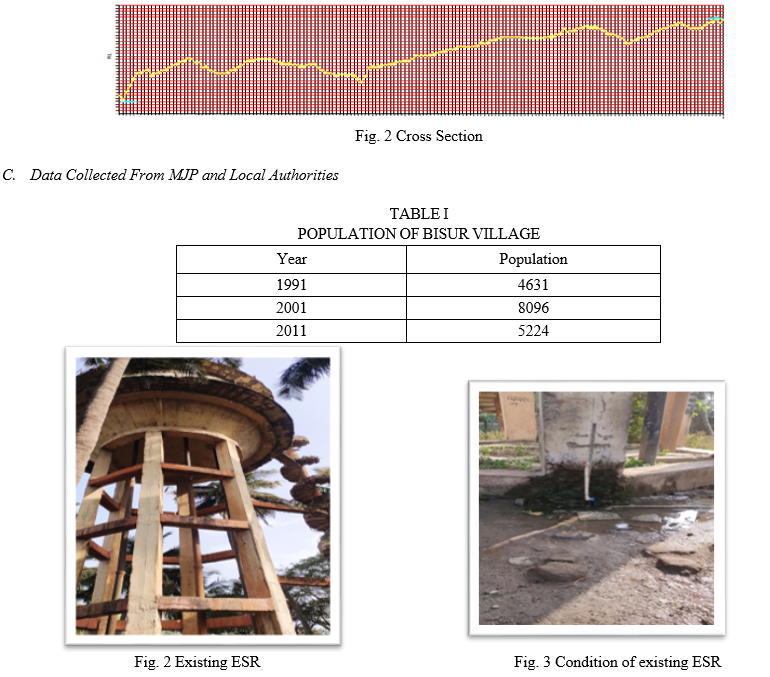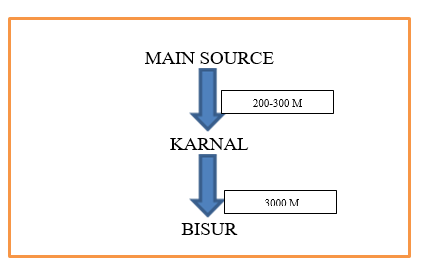Ijraset Journal For Research in Applied Science and Engineering Technology
- Home / Ijraset
- On This Page
- Abstract
- Introduction
- References
- Copyright
Design of Water Supply Scheme for Bisur Village
Authors: Ms. Sakshi Pandurang Tarapure, Mr. Prathamesh Santosh Tule, Ms. Sneha Gokul Surane, Mr. Nivrutti Santosh Chaudhari, Prof. Satish A. Pitake
DOI Link: https://doi.org/10.22214/ijraset.2022.42660
Certificate: View Certificate
Abstract
In order to meet the water demand of the continuously growing population of Bisur village and failure of current water supply system it is essential to provide the sufficient and uniform quantity of water through the design of various units of water treatment plant, so for design work we have collected information of proposed area like Main water source, Population, Demand of water, quality of water, distribution network and water tanks etc. from MJP (Maharashtra Jeevan Prabhakaran) and local authorities. After analysed above data we calculated (i) Future population (ii) Water characteristics (iii)Design Period (iv)Water demand [101 LPCD]. After conducting and analysis of survey data we proposed an efficient new alignment for water distribution system and we designed various units of water treatment plant like Aeration, Alum Tank, Tube settler, Rapid Gravity filter, rising main, Jack Well, Sump etc. This proposed design of the water supply scheme for proper supply of water is sufficient to meet the daily requirement of water in selected area.
Introduction
I. INTRODUCTION
Water is one of the essential requirements for life. All living things need water for their survival. Water is used for various purposes including drinking, food preparation, irrigation and Manufacturing. Although water covers more than 70% of the earth’s surface, less than 1% of that source is available as freshwater. The use of water is increasing rapidly with our growing population. In ancient times every individual or family was responsible to arrange for their water supplies. There was no collective effort by the whole community for it. But as the community developed it became essential to have public water supply soon the inhabitants realized that their local sources of water supply such as shallow wells, springs, cisterns, etc. are inadequate to meet the demand of the town, they started to collect the water from distant large sources and conveyed it to the town through aqueducts, canals, etc. when the concentration of town increases, it becomes very difficult to locate wells. In addition to this source of water, having good quality was less readily available. These all situations lead to the development of public water supply schemes. Water treatment involves science, engineering, business & art. The treatment may include mechanical, physical, biological & chemical methods. As with any technology, science is the foundation & engineering makes sure that the technology works as designed.
The work of construction & maintenance of water supply & waste water disposal systems is generally undertaken by government agencies – Public Health Engineering or Environmental Engineering Department, Civil Engineers execute these departments.
II. GENERAL WORK INFORMATION ABOUT BISUR VILLAGE
A. Bisur Village
The village Bisur located in Sangli district of Maharashtra the area of village is 1087 Ha. Including agriculture. The main income source of villagers is farming so water is one of the essential requirement for villagers and water availability is insufficient as per survey taken so we under taken the design of water treatment plant for a village Bisur.
B. Existing Water Supply Arrangement & Necessity of the Project
The existing water supply scheme for village Bisur is RRWS (Regional Rural Water Supply Scheme).
For RRWS one source is selected which has sufficient water availability for 12 months. Five to ten villages are selected from study of top sheet. A suitable central location is selected for WTP at higher elevation. Treated water is supplied by rising main or gravity main to the villages. Master balancing ESR/Reservoir is also provided. ESRS are provided at each village. Distribution system is designed for each village. The scheme is maintained separately. The operation and maintenance cost is divided as per number of families or per number of connections of each village. The water tax is charged per family/ per connection.
The scheme was initially accepted by the villagers. But after some years of operations, villagers were not satisfied about the performance of the scheme.

C. Problems due to RRWS Scheme
- Maintenance Problems
a. Due to improper maintenance there are leakages during distribution in rising main.
b. Due to unviability of workers there is no periodic maintenance
2. Pending Bills
a. According to MJP and irrigation Department the structure of bill of water supply is
Electricity = 70%
Water charges = 20%
Maintenance = 10%
c. Ex: for Bisur village total water charges for 1 year are Rs. 1200/connection.
d. Due to uncertain supply of water in some part of villages, people are not ready to pay the bills.
e. The bill is not affordable to some people so they are unable to pay.
3. Leakages
a. Length of Rising Main is about 11km.
b. Length of Gravity Main is about 25km.
c. Pipe is laid by side of the road.
d. Road is crossed by small farm roads.
e. Leakage through Air Valves.
f. Unsupported rising main and gravity mains.
g. Due to collision of vehicle R.M. damages.
h. Nala or stream crossing.
Sufficient amount of water is not supplied to villages so they steal water for external use. Adjacent villages use more water so there is shortage of water in the upcoming village. Over lifting of water from ground surface Source. Due to this all problems there is need of new water supply scheme.
III. LITERATURE REVIEW
Jayee university of Information Technology have represented a review on water quality assessment of natural and its importance an over. This paper focuses on the complete water quality determination not only requires the physical, chemical, biological components but also requires assessments of toxically components like metals and heavy nutrients from chemical fertilizers.
M. Murugandham, M. Swaminathan has represented a review on recent development in homogeneous advanced Oxidation process for water treatment. This paper concluded that the influence of various experimental parameters such as oxidant dosage, solution Ph , flow rate substrate concentration , water matrix and light intensity on the AOPs was explored. Committee of CPCB (Central Pollution Control Board) Government of India have represented a review on Indicative Guideline for restore of water bodies (Polluted Rivers, Lakes and Ponds) this paper plays an role in maintaining and restoring the ecological balance. They Act as sources of Drinking water, recharge ground water and provide live hood opportunities to a large no. of people.
International Research Journal of Engineering and Technology (IRJET) have represented a review on Design of water treatment plant. This paper concluded that the design of Water Treatment Plant for proposed village has been completed. the water Quality Analysis showed excess amount of Iron and MPN value. They can be mitigated by Aeration, sedimentation, Filtration and disinfection. All other chemical parameters were within the limits. Design of Treatment plant consist of pump house, Cascade Aereator , flash mixer , clariflocculator , Rapid sand filter , water storage tanks ( ground level and overhead tanks). With this project the utilizable water scarcity and related issues of the people of respective village has been nullified.
IV. DATA COLLECTION AND ANALYSIS
A. House Survey
As a part of design of water supply scheme for proposed village, the household water consumption survey is important to know actual requirement of water per capita. The survey was carried out for a all houses from village. The questionaries were framed for collecting data as Daily consummation, Water storage, Need of water for livestock, Monthly water bill, Filter media. Analysis of above data lead to Average water required is 101 litters per capita. This does not include water required for livestock.
B. Rising Main Survey
Design of Water Treatment Plant requires need of RL’s calculation for finalising head. In profile levelling the section drawing is prepared as per below.

D. Population Forcasting
If water supply scheme is designed for the present population, it will be inadequate within few coming years, as population increases continuously.
All components of water supply scheme when once constructed cannot be easily modified hence; various components of the water supply scheme are designed to supply water for the population of the town or city for the end of the design period. Therefore, it is necessary to find the population of the town/city at the end of the design period.
There are various methods of population forecasting:
1. Arithmetical increase method. 2. Geometrical increase method. 3. Incremental increase method. 4. Decrease rate of growth method. 5. Simple graphical method. 6. Graphical comparison method. 7. Zoning method. 8.The logistic curve method.
For designing of water supply scheme we have forecasted the population by using selected method from above list : -
1. Arithmetical increase method. 2. Geometrical increase method 3. Incremental increase method.
TABLE III
FORCASTED POPULATION OF BISUR VILLAGE
|
SR. NO. |
METHOD |
FORMULA |
YEAR |
POPULATION |
|
1 |
Arithmetical Increase Method |
Pn = P + nd |
2021 2031 2041 |
5521 5817 6114 |
|
2 |
Geometrical Increase Method |
Pn= P[1+r/100] n |
2021 2031. 2041 |
6251 7479 8950 |
|
3 |
Incremental Increase Method |
Pn = P + nd + n (n+1)/2 * t |
2021 2031 2041 |
6114 7596 9672 |
- Calculations For Design Period Population
As we are designing water supply scheme for 15 years i.e. up to year 2037, so by interpolation we have calculated the population for year 2037.
TABLE IIIII
INTERPOLATION
|
METHODS |
POPULATION |
|
Arithmetical increase method |
5902 |
|
Geometrical increase method |
7920 |
|
Incremental increase method |
7920 |
Average of these 3 method = (5902+7920+8215) / 3
= 7350
Hence, The Design Population of year 2037 is 7350.
2. Route (Alignment) Finalization for WTP

V. DESIGN OF VARIOUS UNITS OF WTP
Different units for water treatment plant unit like Aeration Fountain, Alum Tank, Tube Settler, Rapid Gravity Filter, Underground sump, Rising Main, Jack Well, Pump for Sump
Data Available
- Population - 7350 (for year 2034).
- Water Demand - 40 Lpcd (as per government rules).
- Water required - 7350*40
= 2, 94,000 litters per day.
4. Add 15% for floating population and wastages, losses, etc.
So, total water required = 3, 38,100Lit/day = 3, 40,000 Lit/day
A. Design Of Aeration Fountain
- Capacity - 340000/1000*8 = 42.5m3/hr. (assuming 8 hrs. pumping per day)
- No. of Cascades - 3nos.
- Minimum rise of Cascades - 200mm.
- Minimum tred of cascades - 300mm.
- Diameter of central inlet pipe- It should be such that maximum velocity is limited to 0.6 m/sec.
Q = 42.5m3/hr.
= 0.708m3/min.
From Hazen-William flow chart, c=100.
Provide 200 mm diameter inlet riser pipe giving,
V=0.37m/sec. < 0.6 m/sec.
Hf = 6m/1000m.
The area of cascade aerator to be 0.03 m2/m3/ hr
B. Design Of Alum Tank
Strength of solution - 2%
Alum dose- 20mg/lit (11 mg/lit as per test)
- No. of alum tank- 1 no.
- Rating of tank- 8 hrs.
- Capacity of tank for dosing 20*42500/1000 = 850 litres
Alum tank of size 2*0.5*1m is provided.
C. Design Of Tube Settler
Data required –
- Average output required from tube settler = 3, 40,000/8 = 42.5m3/hr
- Loss of water = 2.5%
- Total output required = 42.5*1.025 = 43.562 = 44m3/hr
- Settling velocity of smallest particle to be removed= (Vs) = 120m/day
- Settling tube diameter = 50mm/100mm/150mm
- Length of tube = 1m
- Angle = 00
- Kinematic viscosity of water = 1.01*10-6m2/sec
Table IV
Tube Settler
|
Sr.No. |
Diameter |
Area |
Tubes |
|
1. |
0.05m |
1.93m2 |
983 |
|
2. |
0.1m |
7.39 m2 |
941 |
|
3. |
0.15m |
16.31 m2 |
923 |
Provide 50mm as they are economical.
D. Design Of Rapid Sand Filter
Water required per day = 3, 40,000lit/day.
Assuming 4% of filter water is required for washing of the filter every day we have,
Total filtered water required per day = 3, 40,000/0.96
= 354.17*103 lit/day
Now, assuming that 0.5 hour is lost every day in washing the filter,
We have filtered water required per hour = 354.17*103/7.5
= 47.22*103lit/hr.
Now, assuming the rate of filtration be 5000 lit/hr/m2
We have,
The area of filter required = 47.22*103/5000 = 9.44m2
Say, 10m2.
So provide filters of size 2m*2.5m. (2 numbers)
Filter media data – Gravel = 500mm
Sand = 600mm
Water = 800mm. Keep free board of 300m
E. Design Of Under Ground Sump
Assume sump for 2 hours water storage.
We have,
Rate of filtration = 47200 lit/hr.
For 2 hours = 47200*2 = 94400 lit/hr.
Say, 1 lakh litre capacity sump.
So, we have adopted 7m*3.6m*4m size of sump.
F. Design Of Rising Main
L = 8 km.
Assume PVC 10 kg/cm2 pipe. (High pressure pipe)
Economical diameter of pipe is given by Lea’s formula,
D = a√Q
Where,
D = Diameter of pipe in m.
Q = discharge (m3 / sec)
A = constant. (Ranges from 0.097-1.22)
For rough pipe assume less and for smooth pipe assume more.
D = 1.2√Q
Calculations of Q (Discharge):
Total requirement of water = 3, 40,000/day = 0.0118m3/sec.
D = 1.2√0.0118
= 0.130
= 130mm
Assume, 150mm. (130 internal diameter pipe is not available)
Check for velocity:
Q = AV
0.0118 = π/4 *0(0.150)2*V
V = 0.667 m/sec. < 0.8 m/sec ...ok
G. Design Of Pump For Jack Well
Head calculation:
Total head loss = static head + frictional head in pipe + head loss due to velocity.
H = HST + hf+ hv
= 35 + hf + hv
Hf = (flv) 2/2gd
= (0.04*8000*(0.667)) 2/ (2*9.81*0.150)
= 48.37 m
Hv = v2/2g
= (0.667)2/ (2*9.81)
= 0.022
H = 35+48.37+0.022
= 83.39 = 84 m.
- Design of Centrifugal Pump
BHP = 0.0118*1000*84/75*0.75.
= 17.62HP.
Say, 18HP…………….1
2. Design of Submersible Pump
42500*15/13.23 = 48186 lit/hr. Say, 48200 lit/ hr.
3. Design Of Pump For Sump
Sump is of capacity 1 lakh. We have to pump water 50000 lit/hr.
4. Design of Centrifugal Pump
HP = 0.013*1000*25/75*0.75 = 5.77 Say, 6 HP
5. Design of Submersible Pump
HP = 833.33*25/4500 = 4.62 Say, 5 HP.
So, we have adopted submersible pump of 5 HP and we have to keep one stand-by pump of 5 HP.
VI. RESULT AND DISCUSSION
From data analysis average water required is 101 litters per capita per day without considering water required for livestock. The average population of above three methods for year 2037 is 7350 which is considered for designing of proposed WTP. As per above design methods results for various WTP units are found out as per below.
Table VII
Designs of Units of water Treatment Plant
|
Sr. No. |
UNITS |
Design result |
|
1 |
Aeration Fountain |
Area = 0.03 m2/m3/hr. |
|
2 |
Alum Tank |
Volume = 2*0.5*1 m3 |
|
3 |
Tube Settler |
For diameter 0.05 m = 983 No’s
0.15 m = 923 No’s |
|
4 |
Rapid Sand Filter |
Area = 2*2.5 m2 (2 nos ) |
|
5 |
Underground sump |
Volume = 7*3.6*4 m3 |
|
6 |
Rising Main |
Diameter = 150 mm |
|
7 |
Jack Well |
H = 84 m |
|
8 |
Pump for Sump |
For centrifugal pump = 6HP For submersible pump = 5HP |
According to the above design results of various WTP units and proposed new alignment, the villages' water needs would be fulfilled. Water scarcity and related concerns for the population of Bisur village would be abolish and proposed water treatment facility, which will be sufficient for the next 15 years.
References
[1] WarrenViessman, J.R., & Hammer, M. J. (1985). Water Supply and Pollution Control, 4th edition. Happer &Row, Publishers, NewYork. [2] Hammer, M. J. & Hammer, Jr. M. J. (1996). Water and Wastewater Technology. 3rd edition. Prentice–Hall, Inc. [3] Singh, G. & Singh, J. (2003). Water Supply and Sanitary engineering. 6th edition. Lomus offset press, Delhi. [4] Brandt M.J., Johnson K.M., Elphanston A.J., & Ratnayaka D.D. (2017). Twort’s Water Supply. 7th Edition, Published by Elsevier Ltd. [5] Huang J.Y.C., & Garcia-Maura F. (1986). Effect of Influent Property on Filter Performance. J. of Envr. Eng.Div. 112(4). [6] Mohammed, O.I. (1989). A Comparison Between the Performance of the Conventional and the Dual-Media Filters. M.Sc. thesis, Civil Engineering Department, University of Basrah, Iraq [7] Rashid, M. A. (1989). Treatment of Tigris river water by direct filtration. M.Sc. thesis, University of Baghdad, Iraq. [8] Al-Anbari, R.H.H. (1997). Selected Alternatives for Up-Grading Existing Water Treatment-Plants: A Qualitative and Qualitative Improvements. PhD thesis, Building and Construction Department, University of Technology, Iraq. [9] Aziz, S. Q. (2000). Treatment of Greater–Zab Water by Rapid Filtration. M. Sc. Thesis, Department of Civil Engineering, College of Engineering, Salahaddin University–Erbil, Erbil, Iraq. [10] Aziz, S.Q. (2009). Determination of Floc Volume Concentration in Filter Beds by Using New Methods. Thirteenth International Water Technology Conference, IWTC 13, Hurghada, Egypt.
Copyright
Copyright © 2022 Ms. Sakshi Pandurang Tarapure, Mr. Prathamesh Santosh Tule, Ms. Sneha Gokul Surane, Mr. Nivrutti Santosh Chaudhari, Prof. Satish A. Pitake. This is an open access article distributed under the Creative Commons Attribution License, which permits unrestricted use, distribution, and reproduction in any medium, provided the original work is properly cited.

Download Paper
Paper Id : IJRASET42660
Publish Date : 2022-05-13
ISSN : 2321-9653
Publisher Name : IJRASET
DOI Link : Click Here
 Submit Paper Online
Submit Paper Online

